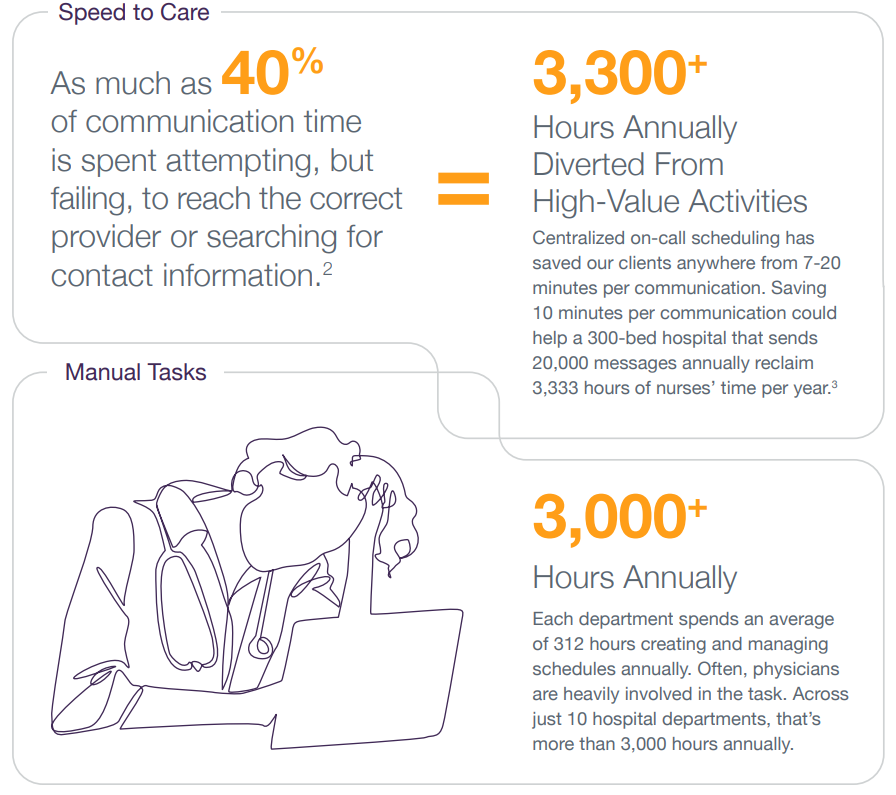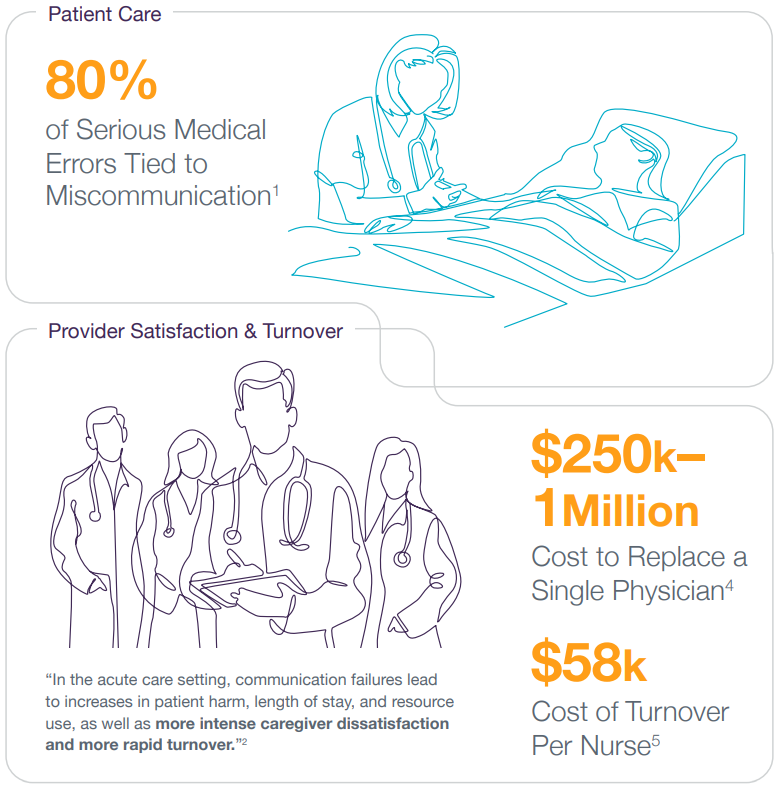Live Session
A Roadmap for Change Management Projects
Register NowTABLE OF CONTENTS
The impact of call schedules is more widespread than you might expect. Whether it’s a paper calendar pinned to the bulletin in the nurse’s station or a centralized file on the hospital intranet, an on-call schedule can help accelerate—or immobilize—critical patient care.
“I was used to paper scheduling, but now I see real-time updates in the schedule and how beneficial those are.
If a patient in room 264 needs pain medicine but a patient in 271 needs a bolus because they are tanking, I can reach into my pocket, look at a device, and see which provider is on call. That is how I sell a lot of naysayers on the system.
If I look at a Rolodex or paper to find the phone number of who is on call, that could take 25–35 minutes, and that is if no interruptions happen. If I can pull something out, find the schedule, and text the provider that a patient needs a bolus all in under 55 seconds, that is so much easier.
This product is incredible for bedside workers. In today’s age where bedside providers are underneath a microscope for every single decision they make, Lightning Bolt Scheduling is imperative.”
– Analyst/Coordinator
Collected by KLAS Research, April 2023
Let’s take the emergency department (ED) as an example. Do you know where call schedules are located in the ED? Chances are, you can find them in more than one place. Most likely, they all reflect different information.
The result? Care delays and miscommunication—which are tied to 80% of all medical errors.1
For example:
A patient arrives in the ED in need of emergent care from a specialist. A nurse, provider, or other care team member walks to the nurse’s station, looks at the schedule, and contacts a provider who says, “I’m not on call. I swapped shifts with Dr. Green last week!” Or—even worse—the care team member can’t get in touch with any provider and is left trying to decipher who is on call while the patient is left waiting.
What’s worse is when the inefficient process is repeated, department by department, throughout your entire hospital. And the problem is not limited to hospitals still using pen and paper to manage call schedules.
On-call schedules are foundational to clinical communication, and delayed or inadequate communication can directly increase patient risk, decrease provider satisfaction, and lead to detrimental patient outcomes.


Inefficient on-call schedule management and communication processes can have significant consequences across your organization. The scheduling and communication challenges that some hospitals face are linked to outdated methods, which should be replaced with the right technology to best manage on-call schedules.
Rather than hiring additional personnel to handle time-consuming manual tasks associated with managing call schedules and keeping them up to date, leading hospitals and health systems implement a single on-call scheduling solution across their enterprise to reap significant benefits.
1
No more searching for the latest schedule or trying to find Dr. Smith’s new cell phone number—all the on-call schedules from across your hospital are available in one place where care team members can contact on-call providers in just a few clicks. The daily on-call view also updates automatically as changes are made—no refreshing required.
As the dedicated on-call scheduling solution for University of Kentucky Healthcare, Lightning Bolt helped decrease time to contact the on-call provider from 8.25 minutes to 61 seconds—an 88% reduction.
2
Physicians, nurses, and other care team members are your hospital’s most valuable resources. With an advanced on-call scheduling solution, you can automate and streamline many of the peripheral tasks keeping them away from direct patient care. Simplify care coordination further with an easy click-to-connect workflow that integrates with key IT systems to contact on-call providers.
3
Poor patient experiences are driving more patients to look for care outside of traditional healthcare settings. Accurate, visible, and up-to-date on-call schedules eliminate key communication barriers that slow patient care and can help minimize patient leakage.
4
Click fatigue and technology overload are prevalent in healthcare. Providers sometimes lament that too much of the technology they use every day was originally touted as a solution for easing their workload, when in reality it ends up contributing to greater dissatisfaction and burnout. Digital scheduling solutions, on the other hand, are the kind of technology that providers want, especially if a single solution is deployed across the health system to reduce the number of apps required.
5
With Lightning Bolt’s daily on-call view, users can easily see who recently finished a call shift, who’s working now, and whose shift is coming up. For example, if it’s 6:55 AM and a shift change is coming up at 7 AM, it might make more sense to pose a patient care question to the person who’s about to begin their shift than speaking with someone who’s about to clock out. These views are also automatically refreshed, so when a group like cardiology changes their call schedule, that change will instantly be reflected in the daily on-call view. No need to refresh any views to see the most up-to-date schedule!
6
Using a variety of scheduling processes, tools, and technologies across your organization may be costing you. A mix of scheduling vendors and local spreadsheets burdens your IT team to maintain and support multiple integrations. Without a single source of truth, centrally accessible, this inconsistent approach also increases the total cost of ownership for your organization.
7
An enterprise scheduling solution like Lightning Bolt can grow as your needs evolve. Maybe your organization only needs on-call scheduling now, but in a few months, you want to see clinics, ORs, administrative time, or anything else that makes up a complete schedule. Later on, you may elect to take advantage of additional automation features, or maybe your organization goes through a merger or acquisition that necessitates a significant rethink of scheduling workflows. Regardless of the pace of change, Lightning Bolt can meet the needs of the moment.
A rules-based, enterprise-wide physician scheduling solution offers a more efficient way for your hospital to manage on-call schedules to help accelerate speed to care, improve the patient experience, and drive care team satisfaction. Learn how your organization can get started with a scheduling solution that drives real results for organizations like yours.


1. Joint Commission Center for Transforming Healthcare Releases Targeted Solutions Tool for Hand-Off Communication, Aug. 2012: jointcommission.org
2. Improving Patient Safety Through Provider Communication Strategy Enhancements, Agency for Healthcare Research and Quality (US), Dingley, C. et al., Advances in Patient Safety: New Directions and Alternative Approaches—Vol. 3, Aug. 2008: ncbi.nlm.nih.gov/books/NBK43663
3. UK HealthCare: Reclaiming 1,000+ Hours Per Year With Optimized Scheduling, PerfectServe, 2020: perfectserve.com/ success-stories/time-savings-uk-healthcare/
4. At Stanford, physician burnout costs at least $7.75 million a year, American Medical Association, Sara Berg, American Medical Association, Nov. 17, 2017: ama-assn.org/practice management/physician health/stanfordphysicianburnoutcosts-least-775-million-year
5. The High Cost of Nurse Turnover, The University of New Mexico, Nov. 30, 2016: rnbsnonline.unm.edu/articles/highcostof-nurse-turnover.aspx
6. Physician satisfaction with a multi-platform digital scheduling system, Deliberato, R. et al., PLOS ONE, Mar. 22, 2017: journals.plos.org/plosone/article?id=10.1371/journal.pone.0174127